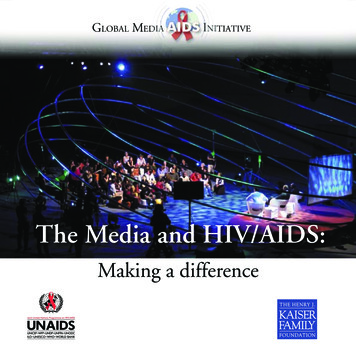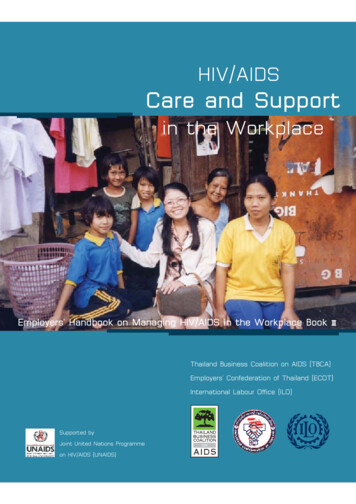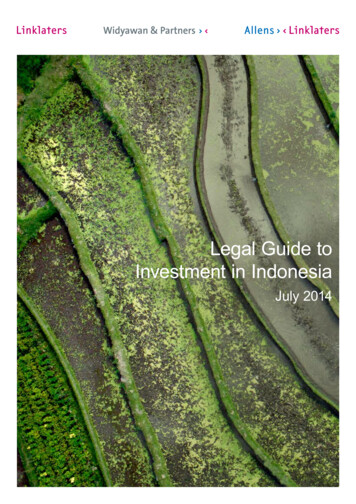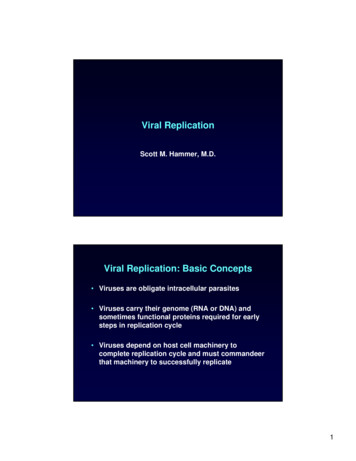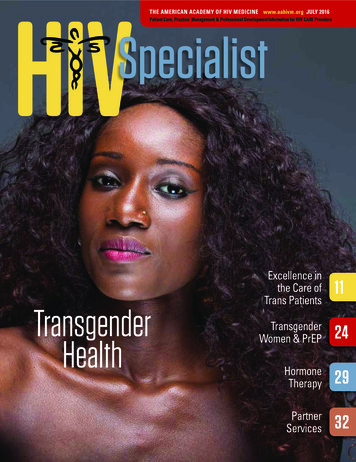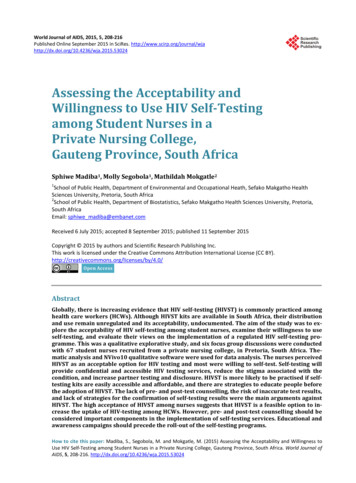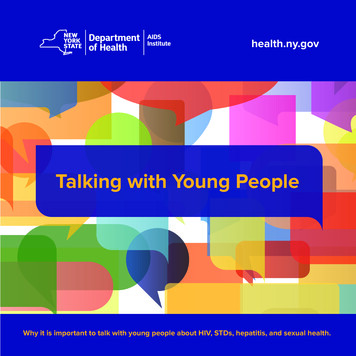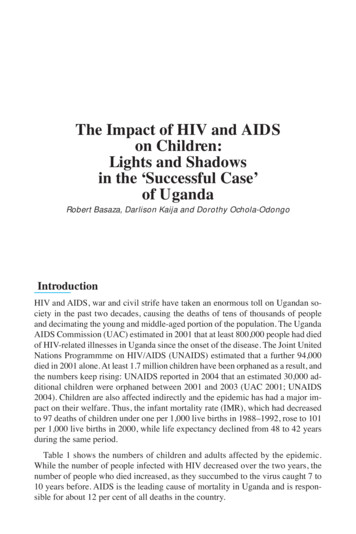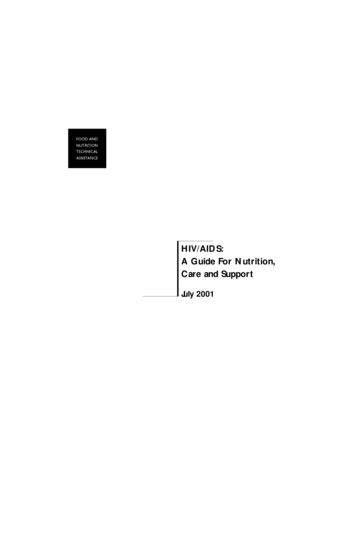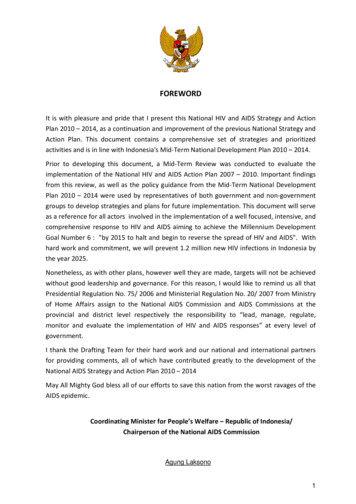
Transcription
FOREWORDIt is with pleasure and pride that I present this National HIV and AIDS Strategy and ActionPlan 2010 – 2014, as a continuation and improvement of the previous National Strategy andAction Plan. This document contains a comprehensive set of strategies and prioritizedactivities and is in line with Indonesia's Mid-Term National Development Plan 2010 – 2014.Prior to developing this document, a Mid-Term Review was conducted to evaluate theimplementation of the National HIV and AIDS Action Plan 2007 – 2010. Important findingsfrom this review, as well as the policy guidance from the Mid-Term National DevelopmentPlan 2010 – 2014 were used by representatives of both government and non-governmentgroups to develop strategies and plans for future implementation. This document will serveas a reference for all actors involved in the implementation of a well focused, intensive, andcomprehensive response to HIV and AIDS aiming to achieve the Millennium DevelopmentGoal Number 6 : "by 2015 to halt and begin to reverse the spread of HIV and AIDS". Withhard work and commitment, we will prevent 1.2 million new HIV infections in Indonesia bythe year 2025.Nonetheless, as with other plans, however well they are made, targets will not be achievedwithout good leadership and governance. For this reason, I would like to remind us all thatPresidential Regulation No. 75/ 2006 and Ministerial Regulation No. 20/ 2007 from Ministryof Home Affairs assign to the National AIDS Commission and AIDS Commissions at theprovincial and district level respectively the responsibility to “lead, manage, regulate,monitor and evaluate the implementation of HIV and AIDS responses” at every level ofgovernment.I thank the Drafting Team for their hard work and our national and international partnersfor providing comments, all of which have contributed greatly to the development of theNational AIDS Strategy and Action Plan 2010 – 2014May All Mighty God bless all of our efforts to save this nation from the worst ravages of theAIDS epidemic.Coordinating Minister for People’s Welfare – Republic of Indonesia/Chairperson of the National AIDS CommissionAgung Laksono1
TABLE OF CONTENTSEXECUTIVE SUMMARY . 8Chapter 1: Introduction. 111.1. Background. 111.2. Rationale . 111.3. Development of Indonesia’s National AIDS Strategy and Action Plan 2010-2014 . 12Chapter 2: The Epidemic and Response to HIV and AIDS . 142.1. Situation of the AIDS epidemic.142.2. Responses to HIV and AIDS .162.3. Challenges.22Chapter 3: Strategies for HIV and AIDS Response. 243.1. Direction of National Policy.243.2. Principles and Background of Policies.253.3. Goal and Objectives.263.4. Strategies.27Chapter 4: Action Plan - Priority Area and Geographic Focus. 314.1. Priority Areas .314.2. Geographic Focus .33Chapter 5: Implementation of Action Plan. 345.1. Governance and Leadership.355.2. Coordination of Implementation .365.3. Principle of Partnership .39Chapter 6: Resource Needs and Resource Mobilization. 416.1. Human Resources.416.2. Financial Resources .436.3. Commodities and Infrastructure .47Chapter 7: Monitoring and Evaluation . 497.1. Annual Program Coverage Targets.497.2. Performance Framework and Indicators.497.3. Monitoring and Evaluation Mechanism.517.4. Capacity Building .53Chapter 8: Conclusion . 54ANNEXES .Error! Bookmark not defined.1.2.3.4.5.6.7.8.HIV and AIDS related regulations, policies and lawsDetailed activities of Strategy and Action Plan 2010-2014Annual Targets of Program CoverageProcess for selection of Priority DistrictPriority Districts selectedDetail Budget to Implement Strategy and Action Plan 2010-2014Indonesia National Performance IndicatorsDiagram of Role and Function the Members of National AIDS Commission in HIV andAIDS response2
LIST OF TABLESTable 4.1. Priority Districts and CitiesTable 6.1. Summary of Estimated Human Resources Needs for implementation of 2010 –2014 National Action PlanTable 6.2. Annual financial resource needs for each program 2010-2014 in USDTable 6.3. Fund Needed for Implementation 2010-2014 by Component of Program andActivitiesTable 6.4. Commodity and Infrastructures Need for Prevention, Care, Support andTreatment: 2010-2014Table 7.1. Targets of Coverage for Prevention Programs targeting Key PopulationsLIST OF GRAPHS and CHARTSPicture 2.1. Map of AIDS epidemic in IndonesiaPicture 2.2. AIDS Epidemic in the FuturePicture 2.3. Universal Access Targets for 2010 compared to Coverage Achieved (2006-2008)and Coverage Planned (2010-2014)Picture 2.4. Financial Resources: Increase in Domestic Funding for AIDSPicture 3.1. Projection of number of PLHIV in Indonesia: Scenario 1 and Scenario 2Picture 3.2. Projection of number of PLHIV in 31 Provinces: Scenario 1 and Scenario 2Picture 3.3. Projection of number of PLHIV in Papua and West Papua Provinces: Scenario 1and Scenario 2Diagram 5.1. Coordination of Implementation of AIDS National Action PlanGraphic 6.1. Funding needs for implementation of Action Plan in 31 provincesGraphic 6.2. Funding needs for implementation of Action Plan in Papua and West Papua2010 – 2014Graphic 6.3. Estimate of Funding Needs, Availability, and Gap for the Implementation ofNational Action Plan 2010 – 2014.Diagram 7.1. Monitoring and Evaluation FrameworkDiagram 7.2. Reporting Flow3
ACRONYMS AND ABBREVIATIONSART or ARVAntiretroviral Therapy or AntiretroviralAusAIDAustralia Agency for International DevelopmentBAPPENASNational Development Planning AgencyBCCBehavior Change CommunicationBPSCentral Statistics BureauBSSBehavioral Surveillance SurveyCDCCommunicable Disease CentresCSTCare, Support and TreatmentDACDistrict AIDS CommissionFSWFemale Sex WorkersGFGlobal Fund for AIDS, TB, and MalariaHIVHuman Immune Deficiency VirusIBBS MARPIntegrated Bio-Behavioral Surveillance in Most at Risk PopulationsIECInformation, Education, CommunicationIDUInjecting Drug Use/ UserIPFIndonesia Partnership Fund for AIDSM&EMonitoring and EvaluationMDGMillennium Development GoalsMMTMethadone Maintenance TherapyMoHMinistry of HealthMSMMen who have Sex with MenNACNational AIDS CommissionNGONon-Government OrganizationNSPNeedle/Syringe ProgramOIOpportunistic InfectionPACProvincial AIDS CommissionPLHIVPeople living with HIVPMTCTPrevention of Mother to Child Transmission of HIVPSMProcurement Supply ManagementSTISexually Transmitted InfectionsSOPStandard Operational ProcedureTBTuberculosis4
UNAIDSJoint United Nations Program on HIV and AIDSUNGASS (AIDS)United Nations General Assembly Special Session (AIDS)USAIDUS Agency for International DevelopmentVCTVoluntary Counseling and TestingWariaIndonesian term for transgender people5
TERMINOLOGYGeographic Focus: Priority areas were established in order to ensure that programimplementation reach as many people of the key populations as possible. Three maincriteria were used to select the geographic areas: (i) HIV transmission risk, (ii) HIV and AIDSdisease burden, and (iii) the province’s ability to implement an effective AIDS response. Therisk of HIV transmission is measured by calculating the total number of people among keypopulations, particularly the number of injecting drug users and sex workers; while thedisease burden is measured against the total number of PLHIV. The ability of the province toimplement an effective response to AIDS is measured by institutional management capacityas well as capacity building for implementation of work at field levelStructural Intervention: Interventions related to physical structure/ environment, socialcondition of the society, economic, political and cultural condition, as well as the law andregulations to increase the efficiency of the response to HIV and AIDS. These interventionsare directed towards establishing a wider and more conducive environment to ensureoptimum response to and effectiveness of HIV program implementation. The interventionsmay include revising non-supportive policies; promotion/ creation of a social/ communityorder that is more supportive to issues related to HIV and AIDS, the key populations,condom use, and reduction of stigma and discrimination.Civil Society: Groups of community members (aside from family relatives, friends, and coworkers) with similar interests who gather voluntarily to express their ideas and beliefs andto work for their achievement. The term "civil society" does not refer to either the privatesector or to government. The United Nations has defined civil society as being made up ofmass organization (such as agricultural, women, or retired workers organizations), laborunions, professional organizations; organizations of social activists, indigenous peoples,religious and other faith-based groups, academics and mutual support self-help groups. It isimportant for the civil society to take an active role in the response to HIV and AIDS.Impact Mitigation: Impact mitigation is part of the effort to reduce the negative impact ofthe epidemic particularly for people infected and affected by HIV and who are often livinglives which are disadvantaged both socially and economically. Certain social securitymechanisms for disadvantaged people have already been established by the government, aswell as numerous efforts carried out by non-government institutions. In this Strategy andAction Plan, impact mitigation is included because review of work under the former ActionPlan found that there is still room for improvement in this area. By including ImpactMitigation in this Action Plan, related sectors, such as Ministry of Social Affairs, arereminded to carry out special programs to ensure access for those affected and infected byHIV and in need of improved social security, protection, and support.Prevention of HIV infection resulting from Sexual Transmission: This comprehensiveaccelerated program was developed in 2008, following localized success of earlier programsand in response to observation of persistent high STI prevalence and low condom use overthe years in Indonesia. There are four main components in this comprehensive program:behavior change communication, stakeholders’ capacity building, supply management forcondoms and lubricants, and STI treatment in community health centres, along withintensive monitoring of all components and evaluation of behavior change. While the maingoal of this effort is to reach and influence female sex workers and their clients, the newaspect of this program as contrasted with former approaches is the addition of structuralinterventions and involvement/ mobilization of the whole community.6
Key Population: Key populations determine the success of prevention and treatment fortheir own benefit as well as for other people. It is because of this, that it is important thatpeople of key populations participate actively in the response to HIV and AIDS. Among keypopulations are people at elevated risk of infection: (1) People vulnerable to HIV infection,due to unprotected sex as well as those sharing contaminated injecting equipment; (2)People vulnerable to HIV infection due to their line of work and/ or their environment, suchas migrant workers, refugees, and young people at risk; and (3) people who are living withHIV (PLHIV).Action Plan: The systematic and comprehensive response to HIV and AIDS in this ActionPlan will be carried out in areas with the highest HIV prevalence and highest number ofpeople of key populations. Specific structured programs will be planned and carried out toreach, work with, and serve all key populations. The Action Plan involves many differentstakeholders at all levels, both government and the community, in order to achievebehavior change that will reduce transmission of HIV infection, so that individuals, familiesand community at large can live full and productive lives and both contribute to and enjoythe benefits of development.Universal Access: Refers to all objectives of universal access related to prevention, care andtreatment. For Indonesia, Universal Access in the National Strategy and Action Plan 2010 –2014 refers to the main goal of the HIV and AIDS response: to ensure that at least 80% ofpeople of key populations have access to prevention, care, support and treatment services.They need access to prevention programs to obtain information on how to prevent HIVtransmission, assess risk, access condoms and clean needles, access voluntary counselingand testing (VCT), as well as services for STI treatment and other HIV-related care, supportand treatment. PLHIV, on the other hand, need access to ARV therapy, treatment foropportunistic infections, as well as access to meet other needs related to care and support.It is hoped that by improving access to effective prevention and treatment programsutilization of the services will increase and 60% of all key populations will practice safebehavior.Coverage: The term coverage refers to the number of people of key populations reached ina given period of time by effective programs.Direct Sex Worker: A person, male or female, selling sex as an occupation or main source ofincome. Direct Sex Workers may be either street based or based in a brothel or other fixedlocation.Indirect Sex Worker: A person, male or female, working in the entertainment business, suchas in bars, karaoke centres, beauty salons or massage parlors, who to increase their incomealso sell sex. It should be noted that not everyone working in these places sells sex.Informed Consent: Agreement for an action to be carried out which is given by a personafter they have received adequate information to make an informed decision.High Risk Sex: Unprotected sexual intercourse which has the risk of infection with anysexually transmitted infection including the possibility of HIV infection. Sexual intercourse isconsidered high risk if performed without a condom if the partner's status is unknown,when one of the people engaging in the intercourse is HIV positive, or is in the HIV infectionwindow period. Both reducing the number of sexual partners and consistent condom use(either male or female condoms) can reduce the risk of HIV infection.7
EXECUTIVE SUMMARYIntroduction: This Strategy and Action Plan (2010-2014) was developed as a reference for allpartners in the response to HIV and AIDS -- government, non-government, as well asinternational partners. At the national level, the Action Plan will be used as a tool tointegrate HIV issues into national development plans, as well as serving as reference forgovernment departments to develop more AIDS-related technical strategies. At the regionallevel, it serves to inform development of local AIDS Action Plans, which will serve, in turn, asthe basis of local budget development. This document will also be used as an instrument tomobilize funds at the national and international levels.The AIDS epidemic and response: In general, the epidemic in Indonesia is a concentratedepidemic. Integrated bio-behavioral surveillance on HIV and the behavior of keypopulations (2007) yielded the following HIV prevalence levels: 10.4% among Direct SexWorkers; 4.6% among Indirect Sex Workers; 24.4% among Waria; 0.8% among Clients ofFemale Sex Workers; 5.2% among MSM; and 52.4% among Injecting Drug Users. Ascontrasted with the rest of the country, in the provinces of Papua and West Papua (togetherknown as Tanah Papua), there is a generalized epidemic with 2.4% HIV prevalence amongthe general population age 15-49 years1. In order to tailor the response to the epidemic it isimportant to monitor trends in HIV transmission in all settings. For example, overallnationally, transmission of HIV infection is rising among MSM.Presidential Regulation No 75/ 2006 indicated the scaling up of Indonesia's response toAIDS. The regulation expanded and diversified the membership of the National AIDSCommission to include civil society. The Presidential Regulation designates the CoordinatingMinister for People’s Welfare as chair of the National AIDS Commission under and directlyresponsible to the President and stipulates that the AIDS Commission is to have a full timesecretary. In 2006, National AIDS Commission began strengthening AIDS Commissions in 100priority districts/cities. In 2007 this effort was expanded to cover all of Indonesia's 33provinces.Policy development also facilitated the development of more prevention, care, support andtreatment services. Although program coverage has increased, there is still a big gapbetween existing coverage and achievement of universal access targets. With increasingsupport from both National and local budgets as well as from international partners, forexample Global Fund Round 8 (2009 - 2014), universal access targets will be achieved,although not until sometime after 2010.Challenges remain in some programs, as seen in the small increase in condom use amongpeople of key populations from 2002 to 2007. On the other hand progress is seen related toequipment sharing among injecting drug users: fewer injecting drug users are sharinginjecting equipment in 2007 than in 2004. Likewise, the impact of ARV Therapy is significantand positive with AIDS related deaths declining from 46% in 2006 to 17% in 2008.The ratio of domestic funding to external funding for the response to AIDS showsstrengthening of domestic support rising from 22% in 2004 to 51% in 2008. In 2006, thetotal HIV and AIDS budget was IDR 105 billion. By 2008 it had reached IDR 542 billion.1Central Bureau of Statistics & Ministry of Health, Risk Behavior and HIV Prevalence in Tanah Papua (datacollection 2006, publication 2007), Jakarta.8
Some of the challenges faced are: inadequate program coverage and effectiveness to assureachievement of universal access; uncertainty related to program sustainability; weak healthand community service systems; the need to improve good governance in all sectors; as wellas the need to establish more a conducive environment for effective implementation of thefull range of HIV and AIDS programs and services.The Strategy of the Response to HIV and AIDS: It is the strategy to: prevent and reduce therisk of HIV transmission; to improve the quality of life of PLHIV; and to reduce the social andeconomic impact of HIV and AIDS among individuals, families, and the community at largethus enabling and ensuring their full participation as valuable, productive members ofsociety. It is the plan of the Strategy that by 2014 eighty percent (80%) of key populationswill be reached through effective programs and 60% of them will engage in safe behavior.To achieve that target, the following strategies will be followed: Expand and scale-up the coverage of all prevention efforts. Expand and scale-up availability of care, support and treatment services, as well asimpact mitigation. Strengthen partnerships as well as health service and community systems. Increase coordination among stakeholders and effective use of resources at all levels. Improve and expand utilization of structural interventions. Implement evidence-informed program planning, priority setting, and implementation.Action Plan Framework (areas of work and geographic focus): The program framework isstructured around 4 areas 1) prevention; 2) care, support and treatment; 3) impactmitigation programs; and 4) promotion of establishment of conducive environments forprogram implementation.Geographic Focus: Based on a process which included calculating the risk of transmission ofHIV, HIV and AIDS burden, and the condition/ quality of the present AIDS response -- 137districts or 31% of all districts in Indonesia's 33 provinces were selected. With the currentgeographic focus, it is expected that activities will reach 94% of injecting drug users (205,860people); 92% of female sex workers (203,000 people); and 85% PLHIV (164,000 people).Implementation of Action Plan: Implementation of the Action Plan will be promotedthrough strong leadership mechanisms, coordination, partnership, active involvement ofcommunity groups, as well as resource mobilization and it will follow principles of goodgovernance.Resource needs and mobilization: Resource calculations have been made related to humanand financial resources. Human resources for the response to HIV and AIDS include fieldstaff (peer educators, outreach workers, program supervisors, and program managers);personnel at service sites (counselors, specialists, general practitioners, laboratorytechnicians, nurses, administrative staff, nutritionists, midwives, and case managers); andmanagement personnel at the district level (program managers, monitoring and evaluationstaff, finance administrators, and secretaries). Staff needs have been calculated. Humanresource mobilization will be conducted and will include recruitment, information and skillsbuilding, and provision of technical assistance.Funding needed to carry out the 2010-2014 Action Plan is estimated to be IDR 10.3 trillion,or US 1.1 billion. The funds will be used among the four main work areas mentionedabove: 1) prevention (57%); 2) care, support and treatment (28%); 3) impact mitigation(2%); 4) establishment of conducive environments (13%). Activities will be focused on9
effective program implementation in the 137 districts/ cities where 80% of the keypopulations are located.Monitoring and evaluation: There are three main indicators which will be used inmonitoring the AIDS response: coverage, effectiveness and sustainability.Coverage: It is expected that by the end of 2014 program coverage will reach at least 80% ofall key populations. Eighty percent of prison inmates and injecting drug users will already bereached by 2011. Eighty percent of female sex workers will be reached by 2012 and 80% ofMSM and clients of sex workers by 2014.Effectiveness: By 2014, it is hoped 60% of people among the key populations will be usingcondoms consistently, 60% of injecting drug users will not be sharing injecting equipmentand 60% of PLHIV needing ARV will receive regular ARV treatment.Sustainability: It is hope that by the end of 2014 adequate funding will be available for theresponse to HIV and AIDS with 70% coming from domestic sources. Availability of programfunding is a key indicator of program sustainability.Conclusion: This National AIDS Strategy and Action Plan (2010-2014) has been produced inthe context of an established and on-going planning cycle. Implementation of the ActionPlan will be reviewed periodically through mid-term and annual reviews. Findings fromthese reviews will be used to improve the program and the content of plan.10
Chapter 1: Introduction1.1. BackgroundResponding to the escalating number of new HIV infections reported since the year 2000,Presidential Regulation No. 75/2006 was issued to intensify the AIDS response in Indonesia.The AIDS epidemic in Indonesia is one of the fastest growing in Asia2. The Ministry of Healthestimates that without increased efforts to expand and strengthen prevention, treatment,care and support services across the country, Indonesia will have almost twice the numberof people living with HIV and AIDS in 2014 as compared to 2008, rising from an estimated227,700 to 501,400.Mounting an effective and comprehensive HIV and AIDS response in Indonesia requires acombination of efforts -- strategic approaches, tackling of structural factors as well asmobilization of a wide range of partners in government, civil society, and the private sector.The geographic and socio-economic challenges are many in this country. Indonesia, theworld’s fourth most populous nation, is spread over 17,000 islands. It is governed in adecentralized system divided into 33 provinces which are again divided into a total of 500districts. HIV infection has now been reported more than 200 districts and in all 33provinces. As the AIDS epidemic is a global challenge and one of the most complicatedissues of our time, successfully controlling HIV and AIDS in Indonesia will benefit not onlyIndonesia but will also be a contribution to the global response to the epidemic.The 2010-2014 National AIDS Strategy and Action Plan is a continuation of the NationalStrategy and Action Plan for HIV and AIDS in Indonesia 2007-2010 and was developed basedon this background. It will serve as a reference document for all partners in the nationalresponse -- national government, regional governments, civil society, private sector, allimplementing partners, and communities -- to develop their respective HIV and AIDSstrategies and Action Plans. At the national level, the Action Plan will be used as the basicfor mainstreaming HIV into national planning documents. These, in turn, will be basicreference for government departments in developing their respective strategies respondingto AIDS, as well as for local governments (provincial and district) in developing their ActionPlans and budgets. This document will also provide reference for broader resourcemobilization at all levels.1.2. RationaleSince 2007, when the previous Strategy and Action Plan were issued, there have been manydevelopments in Indonesia's response to HIV and AIDS. Aside from developments in theresponse, new data have also become available. Findings of the Integrated Bio BehavioralSurveillance in Tanah Papua confirmed that HIV prevalence among general population aged15 - 49 in had reached 2.4%3. IBBS among Most at Risk Populations in 2007 showed that STIprevalence in Indonesia is high, while condom use remains low4. National AIDS Commission2UNAIDS (2008). Report of global AIDS epidemic 2008.3Central Bureau of Statistics & Ministry of Health, Risk Behavior and HIV Prevalence in Tanah Papua (datacollection 2006, publication 2007), Jakarta.4Ministry of Health & Central Bureau of Statistics, Integrated Biological and Behavior Surveillance (IBBS) Mostat Risk Population in Indonesia 2007, Jakarta.11
monitoring data also shows increased program coverage, although not all targets areachieved yet. These findings, along with program data from implementing partners in theNational response are sufficient to evaluate the progress of program implementationagainst the growth of the AIDS epidemic in Indonesia. A national mid-term review of the2007-2010 National Strategy and Action Plan was carried out in 2009.At the same time, in 2009 there were various important developments in government -- anational general election took place which led to formation of a new cabinet including a newCoordinating Minister for People's Welfare as Chair of the National AIDS Commission anddevelopment of Indonesia's national mid-term development plan (2010-2014) Thesechanges necessitated acceleration of the process for formulation of a new National AIDSStrategy and Action Plan 2010-2014 even though reporting on mid-term evaluation of theprevious National Strategy and Action Plan was not yet complete. The result of these factorswas that the final year of National Action Plan (2007-2010) became first year of the newStrategy and Action Plan (2010-2014).1.3. Development of Indonesia’s National AIDS Strategy and Action Plan 2010-2014The process of developing the new National Strategy and Action Plan ran from March toSeptember 2009 as follows:March:A meeting of the Planning and Budgeting Forum of BAPPENAS (NationalPlanning Board) discussed the integration of the response to HIV and AIDSinto Indones
Treatment: 2010-2014 Table 7.1. Targets of Coverage for Prevention Programs targeting Key Populations LIST OF GRAPHS and CHARTS Picture 2.1. Map of AIDS epidemic in Indonesia Picture 2.2. AIDS Epidemic in the Future Picture 2.3. Universal Access Targets for 2010 compared to Coverage Achieved (2006-2008) and Coverage Planned (2010-2014)
